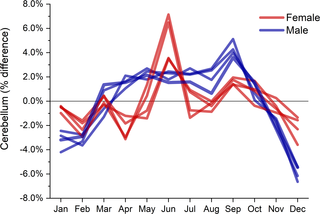Flow
The Cerebellum Flourishes in Spring but May Shrink in Winter
Seasonal changes affect the cerebellum's size in unique and mysterious ways.
Posted October 5, 2021 Reviewed by Abigail Fagan
Key points
- Mammalian brain volumes shrink and expand from season to season. In general, cerebral regions get smaller in summer and larger in the fall.
- However, the cerebellum changes in the opposite direction; it gets bigger in summer and smaller as winter approaches.
- Scientists aren't sure why cerebral and cerebellar brain volume changes move in opposite directions.

Does your brain seem to work differently during seasonal transitions from hotter to colder months and vice versa? If you live somewhere with four seasons, does your brainpower seem to fluctuate as summer gives way to shorter and colder days or when winter fades and "April showers bring May flowers?"
In tandem with Pumpkin Spice Lattes making their return each autumn, September and October in the Northern Hemisphere often feel like a time when a back-to-school mindset takes hold in our brains. As carefree summer attitudes dissipate in the fall, the human brain seems to recalibrate in ways that foster more cerebral pursuits.
Interestingly, a recent neuroscience study (Lim et al., 2018) into the "seasonal plasticity of cognition" found that older adults tend "to have better thinking and concentration in the late summer and early fall than in the winter and spring."
Another recently published 15-year study (Book et al., 2021) of how weather and seasonal changes affect brain volume in a large cohort of people living in the Northeastern United States unearths some surprising discoveries. These open-access findings were published on March 24 in the peer-reviewed journal PLOS One.
In a significance statement, the authors write: "Changes in brain volume due to natural environmental variation have not been reported before and may have implications for weather-related and seasonal ailments."
For this exploratory cross-sectional analysis of the effect of season and weather on the human brain, researchers in Hartford, Connecticut, led by Gregory Book, conducted MRI brain scans of 3,279 healthy individuals during different months/seasons across a 15-year span.

Unlike Cerebral Brain Regions, the Cerebellum Shrinks as Winter Approaches
Notably, the researchers found that for people living in this New England state, numerous brain regions of interest (ROIs) in the cerebrum got bigger from late summer into winter and smaller as spring transitioned to summer. Conversely, brain volume in the cerebellum tended to move in the opposite direction; on average, the cerebellar cortex got bigger in the summertime and smaller in wintertime.
Much like the equator divides the Northern and Southern hemispheres on planet Earth, the tentorium cerebelli is a dividing line that delineates the cerebral and cerebellar hemispheres within the cranial globe. Book et al. found that infra-tentorial regions below this line, in the cerebellum, got noticeably smaller as New Engander's were heading into winter.

On the flip side, supra-tentorial regions above this line, in the cerebrum, grew larger as the weather got colder and days became shorter, as depicted in this graph. The authors explain:
"Left- and right- cerebellum cortex increased in volume between January and June and decreased between July and December. The tentorium acted as a divider between effect direction, with changes from summer to winter months being positive for supra-tentorial regions of interest and negative for infra-tentorial ROIs."
Changes in Barometric Pressure May Be Linked to Brain Volume Changes
Notably, another animal study (Lázaro et al., 2021) of seasonal changes in the mammalian brain found that when bad weather is approaching and barometric pressure drops, supra-tentorial regions tend to gain volume; the approach of winter has a similar effect. However, brain volume in the cerebellum and brain stem (infra-tentorial regions) changed in the opposite direction.
"A possible explanation of brain volume changes is from a change in blood flow as previous studies have found a seasonal effect on ambulatory blood pressure. Blood flow associated with barometric pressure may also offer an explanation," Book et al. write. "However, this does not explain why the cerebellum follows a different pattern from the rest of the brain. Differences may be due to the blood vessels supplying those two regions of the brain, in that the cerebellum and brain stem have a different blood supply than the cerebrum."
In an October 2021 Discover article about this research, Book reiterated that weather-related changes in atmospheric pressure, typically higher in winter and lower in summer, may be linked to fluctuations in brain volume. However, he reiterates that barometric pressure alone doesn't seem to explain why the cerebellum follows a different volume-changing pattern than other parts of the brain.
Circadian rhythm and vitamin D from sun exposure during daylight hours might also play a role in seasonal brain volume shifts. From an evolutionary perspective, the cerebellum is one of our oldest brain regions and has primordial functions that have been preserved since time immemorial. Seasonal changes in cerebellar volume might be an ancestral remnant held over from a bygone era.
In closing, Book and his coauthors note that replication of their analysis should be retested by scanning a single test subject, or group of subjects, on a daily basis throughout an entire year.
"Investigating the biological cause of such large volume changes may be clinically relevant, including why volume changes are observed in opposite directions in the supra-tentorium vs. infra-tentorium," Book et al. conclude. "Investigating these changes further may be informative for seasonal disorders or discover previously unknown seasonal effects on other diseases."
References
Gregory A. Book, Shashwath A. Meda, Ronald Janssen, Alecia D. Dager, Andrew Poppe, Michael C. Stevens, Michal Assaf, David Glahn, Godfrey D. Pearlson. "Effects of Weather and Season on Human Brain Volume." PLOS One (First published: March 24, 2021) DOI: 10.1371/journal.pone.0236303
Andrew S. P. Lim, Chris Gaiteri, Lei Yu, Shahmir Sohail, Walter Swardfager, Shinya Tasaki, Julie A. Schneider, Claire Paquet, Donald T. Stuss, Mario Masellis, Sandra E. Black, Jacques Hugon, Aron S. Buchman, Lisa L. Barnes, David A. Bennett, Philip L. De Jager. "Seasonal Plasticity of Cognition and Related Biological Measures in Adults With and Without Alzheimer Disease: Analysis of Multiple Cohorts." PLOS Medicine (First published: September 04, 2018) DOI: 10.1371/journal.pmed.1002647
Javier Lázaro, Lucie Nováková, Moritz Hertel, Jan R. E. Taylor, Marion Muturi, Karol Zub, Dina K. N. Dechmann. "Geographic Patterns in Seasonal Changes of Body Mass, Skull, and Brain Size of Common Shrews." Ecology and Evolution (First published: February 14, 2021) DOI: 10.1002/ece3.7238




